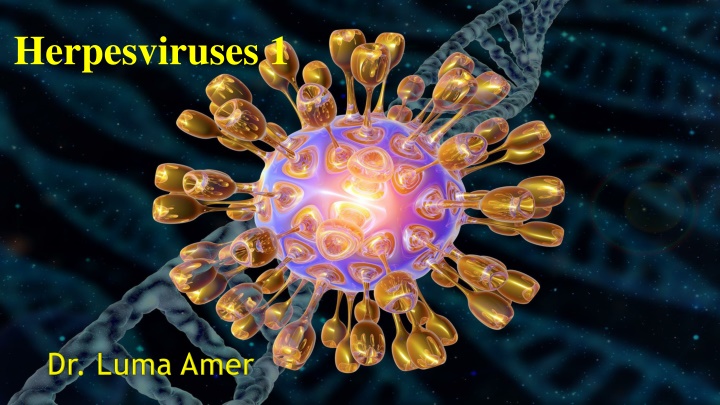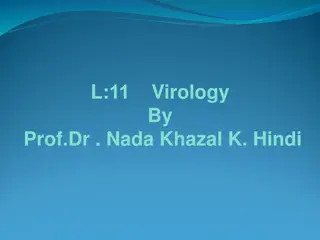Herpesviruses 1
The herpesvirus family includes important human pathogens such as herpes simplex virus types 1 & 2, varicella-zoster virus, cytomegalovirus, Epstein-Barr virus, and human herpesvirus 8. Herpesviruses are known for causing life-long latent infections, with reactivation occurring under certain conditions. Herpes simplex viruses, HSV-1 and HSV-2, exhibit distinct characteristics and can cause a range of diseases. Understanding the general properties and replicative cycle of herpesviruses provides insights into their mechanisms of infection and persistence.
Download Presentation

Please find below an Image/Link to download the presentation.
The content on the website is provided AS IS for your information and personal use only. It may not be sold, licensed, or shared on other websites without obtaining consent from the author.If you encounter any issues during the download, it is possible that the publisher has removed the file from their server.
You are allowed to download the files provided on this website for personal or commercial use, subject to the condition that they are used lawfully. All files are the property of their respective owners.
The content on the website is provided AS IS for your information and personal use only. It may not be sold, licensed, or shared on other websites without obtaining consent from the author.
E N D
Presentation Transcript
Herpesviruses 1 Herpesviruses Herpesviruses
The herpesvirus family contains six important human pathogens: herpes simplex virus types 1 and 2 varicella-zoster virus cytomegalovirus Epstein Barr virus human herpesvirus 8 (also known as Kaposi s herpesvirus) sarcoma associated
General Properties All herpesviruses are structurally similar. Each has an: Icosahedral core surrounded by a lipoprotein envelope The genome is linear double-stranded DNA. The virion does not contain a polymerase. They are large (120 200 nm in diameter), second in size only to poxviruses. Herpesviruses replicate in the nucleus. The virions of herpesviruses possess a tegument located between the nucleocapsid and the envelope. This structure contains regulatory proteins, such as transcription and translation factors, which play a role in viral replication.
Herpesviruses are noted for their ability to cause life-long latent infections. In these infections, the acute disease is followed by an asymptomatic period during which the virus remains in a quiescent (latent) state. When the patient is exposed to an inciting agent or immunosuppression occurs, replication and disease can occur. reactivation of virus
HERPES SIMPLEX VIRUSES (HSV) HSV type 1 (HSV-1) and type 2 (HSV-2) are distinguished by two main criteria: antigenicity and location of lesions. Lesions caused by HSV-1 are, in general, above the waist, whereas those caused by HSV-2 are below the waist. Diseases HSV-1 causes acute gingivostomatitis, recurrent herpes labialis (cold sores), keratoconjunctivitis (keratitis), and encephalitis, primarily in adults. HSV-2 causes herpes genitalis (genital herpes), neonatal encephalitis and other forms of neonatal herpes, and aseptic meningitis. Infection by HSV-1 or HSV-2 is a common cause of erythema multiforme.
Summary of Replicative Cycle The cycle begins when HSV-1 binds first to heparan sulfate on the cell surface and then to a second receptor, nectin. Fusion of the viral envelope with the cell membrane, the nucleocapsid and the tegument proteins are released into the cytoplasm. The viral nucleocapsid is transported to the nucleus, where it docks to a nuclear pore and the genome DNA enters the nucleus along with tegument protein VP16. The linear genome DNA now becomes circular. VP16 interacts with cellular transcription factors to activate transcription of viral immediate early (IE) genes by host cell RNA polymerase. IE mRNA is translated into IE proteins that regulate the synthesis of early proteins such as the DNA polymerase that replicates
Transmission & Epidemiology HSV-1 is transmitted primarily in saliva, whereas HSV-2 is transmitted by sexual contact. HSV-1 infections occur mainly on the face, whereas HSV-2 lesions occur in the genital area. Although transmission occurs most often when active lesions are present, asymptomatic shedding of both HSV-1 and HSV-2 does occur and plays an important role in transmission.
Pathogenesis & Immunity 1) The virus replicates in the skin or mucous membrane at the initial site of infection. 2) Migrates up the neuron by retrograde axonal flow and becomes latent in the sensory ganglion cells. 3)HSV-1 becomes latent in the trigeminal ganglia, whereas HSV-2 becomes latent in the lumbar and sacral ganglia. 4)The virus can be reactivated from the latent state by a variety of inducers (e.g., sunlight, hormonal changes, trauma, stress, and fever), at which time it migrates down the neuron and replicates in the skin, causing lesions.
Laboratory Diagnosis An important diagnostic procedure is isolation of the virus from the lesion by growth in cell culture. ELISAs Detecting virus-specific glycoproteins in enzyme-linked immunosorbent assays . A rapid diagnosis from skin lesions can be made by using the Tzanck smear, in which cells from the base of the vesicle are stained with Giemsa stain. PCR A rapid diagnosis of encephalitis can be made by detecting HSV-1 DNA in the spinal fluid by using a PCR assay, but virus is rarely recovered from the spinal fluid. Serologic tests
VARICELLA-ZOSTER VIRUS (VZV) Disease: Varicella (chickenpox) is the primary disease; zoster (shingles) is the recurrent form. Important Properties: VZV is structurally and morphologically similar to other herpesviruses but is antigenically different. It has a single serotype. The same virus causes both varicella and zoster. Humans are the natural hosts.
Replicative Cycle: The cycle is similar to that of HSV. Transmission & Epidemiology The virus is transmitted by respiratory droplets and by direct contact with the lesions. Varicella is a highly contagious disease of childhood; more than 90% Varicella occurs worldwide. but the widespread use of the vaccine has significantly reduced the number of cases.
Immunity following varicella is lifelong: A person gets varicella only once, but zoster can occur despite this immunity to varicella. Zoster usually occurs only once. The frequency of zoster increases with advancing age, perhaps as a consequence of waning immunity. Clinical Findings: Varicella After an incubation period of 14 to 21 days, brief prodromal symptoms of fever and malaise occur. A papulovesicular rash then appears in crops on the trunk and spreads to the head and extremities. Zoster The occurrence of painful vesicles along the course of a sensory nerve of the head or trunk is the usual picture.
Thank you Dr.Luma.Amer



